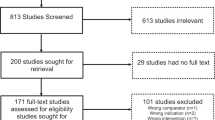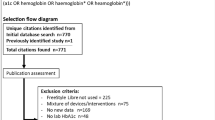Abstract
With the development of flexible electronics and chip technology, the application value of wearable devices in lifelong treatment of chronic diseases is increasing. In view of its rapid development and diversified forms, wearable device-based intervention seems to provide a promising option to solve the problems of long-term glycemic control in type 2 diabetes (T2D). However, to date, it is unclear whether the intervention based on wearable device is effective on glycemic control in patients with T2D. In order to explore whether this choice is effective in glycemic control in patients with T2D, after database search and study screening, 6 studies and 1001 patients were selected from 181studies for this meta-analysis. The results guided that the wearable device-based intervention may be more effective than usual care on glycemic control in patients with T2D. Subgroup analysis showed that when the duration of intervention was equal to or less than 12 weeks, the effect of wearable device-based intervention was significantly different from that of usual care, but when the intervention duration greater than 12 weeks, the effect was not significantly different. The intervention effect of wearable devices with goal-setting or encouragement functions was significantly better than that of usual care, and there was no significant difference between automatic drug delivery wearable devices and usual care. In conclusion, the wearable device-based intervention is effective on glycemic control in patients with T2D. In general, this choice of wearable devices for patients with T2D may be effective to some extent.






Similar content being viewed by others
References
Stumvoll M, Goldstein BJ, van Haeften TW. Type 2 diabetes: principles of pathogenesis and therapy. Lancet. 365(9467):1333-1346, 2005. https://doi.org/10.1016/s0140-6736(05)61032-x
Wu Y, Ding Y, Tanaka Y, Zhang W. Risk factors contributing to type 2 diabetes and recent advances in the treatment and prevention. Int J Med Sci. 11(11):1185-1200, 2014. https://doi.org/10.7150/ijms.10001
Rodriguez-Capote K, Tovell K, Holmes D, Dayton J, Higgins TN. Analytical evaluation of the Diazyme glycated serum protein assay on the siemens ADVIA 1800: comparison of results against HbA1c for diagnosis and management of diabetes. J Diabetes Sci Technol. 9(2):192-199, 2015. https://doi.org/10.1177/1932296814567894
Stratton IM, Adler AI, Neil HA, Matthews DR, Manley SE, Cull CA, et al. Association of glycaemia with macrovascular and microvascular complications of type 2 diabetes (UKPDS 35): prospective observational study. Bmj. 321(7258):405-412, 2000. https://doi.org/10.1136/bmj.321.7258.405
Leslie RD. United Kingdom prospective diabetes study (UKPDS): what now or so what? Diabetes Metab Res Rev. 15(1):65-71, 1999. https://doi.org/10.1002/(sici)1520-7560(199901/02)15:1/65::aid-dmrr3/3.0.co;2-x
Benjamin EJ, Blaha MJ, Chiuve SE, Cushman M, Das SR, Deo R, et al. Heart Disease and Stroke Statistics-2017 Update: A Report From the American Heart Association. Circulation. 135(10):e146-e603, 2017. https://doi.org/10.1161/cir.0000000000000485
Egan BM, Li J, Qanungo S, Wolfman TE. Blood pressure and cholesterol control in hypertensive hypercholesterolemic patients: national health and nutrition examination surveys 1988-2010. Circulation. 128(1):29-41, 2013. https://doi.org/10.1161/circulationaha.112.000500
Selvin E, Parrinello CM, Sacks DB, Coresh J. Trends in prevalence and control of diabetes in the United States, 1988-1994 and 1999-2010. Ann Intern Med. 160(8):517-525, 2014. https://doi.org/10.7326/m13-2411
Pan B, Ge L, Xun YQ, Chen YJ, Gao CY, Han X, et al. Exercise training modalities in patients with type 2 diabetes mellitus: a systematic review and network meta-analysis. Int J Behav Nutr Phys Act. 15(1):72, 2018. https://doi.org/10.1186/s12966-018-0703-3
Gao W, Chen DW, Liu GJ, Ran XW. [Efficacy and safety of vitamin D for type 2 diabetes mellitus: a systematic review]. Zhonghua Yi Xue Za Zhi. 93(18):1401-1406, 2013.
Ojo O, Ojo OO, Adebowale F, Wang XH. The Effect of Dietary Glycaemic Index on Glycaemia in Patients with Type 2 Diabetes: A Systematic Review and Meta-Analysis of Randomized Controlled Trials. Nutrients. 10(3), 2018. https://doi.org/10.3390/nu10030373
Remmers C, Hibbard J, Mosen DM, Wagenfield M, Hoye RE, Jones C. Is patient activation associated with future health outcomes and healthcare utilization among patients with diabetes? J Ambul Care Manage. 32(4):320-327, 2009. https://doi.org/10.1097/JAC.0b013e3181ba6e77
Shen Y, Wang F, Zhang X, Zhu X, Sun Q, Fisher E, et al. Effectiveness of Internet-Based Interventions on Glycemic Control in Patients With Type 2 Diabetes: Meta-Analysis of Randomized Controlled Trials. J Med Internet Res. 20(5):e172, 2018. https://doi.org/10.2196/jmir.9133
Burridge JH, Lee ACW, Turk R, Stokes M, Whitall J, Vaidyanathan R, et al. Telehealth, Wearable Sensors, and the Internet: Will They Improve Stroke Outcomes Through Increased Intensity of Therapy, Motivation, and Adherence to Rehabilitation Programs? J Neurol Phys Ther. 41 Suppl 3:S32-s38, 2017. https://doi.org/10.1097/npt.0000000000000183
Olgin JE, Pletcher MJ, Vittinghoff E, Wranicz J, Malik R, Morin DP, et al. Wearable Cardioverter-Defibrillator after Myocardial Infarction. N Engl J Med. 379(13):1205-1215, 2018. https://doi.org/10.1056/NEJMoa1800781
Jeppesen J, Fuglsang-Frederiksen A, Johansen P, Christensen J, Wüstenhagen S, Tankisi H, et al. Seizure detection based on heart rate variability using a wearable electrocardiography device. Epilepsia. 60(10):2105-2113, 2019. https://doi.org/10.1111/epi.16343
Jakicic JM, Davis KK, Rogers RJ, King WC, Marcus MD, Helsel D, et al. Effect of Wearable Technology Combined With a Lifestyle Intervention on Long-term Weight Loss: The IDEA Randomized Clinical Trial. Jama. 316(11):1161-1171, 2016. https://doi.org/10.1001/jama.2016.12858
Frias J, Virdi N, Raja P, Kim Y, Savage G, Osterberg L. Effectiveness of Digital Medicines to Improve Clinical Outcomes in Patients with Uncontrolled Hypertension and Type 2 Diabetes: Prospective, Open-Label, Cluster-Randomized Pilot Clinical Trial. J Med Internet Res. 19(7):e246, 2017. https://doi.org/10.2196/jmir.7833
Orsama AL, Lähteenmäki J, Harno K, Kulju M, Wintergerst E, Schachner H, et al. Active assistance technology reduces glycosylated hemoglobin and weight in individuals with type 2 diabetes: results of a theory-based randomized trial. Diabetes Technol Ther. 15(8):662-669, 2013. https://doi.org/10.1089/dia.2013.0056
Miyauchi M, Toyoda M, Kaneyama N, Miyatake H, Tanaka E, Kimura M, et al. Exercise Therapy for Management of Type 2 Diabetes Mellitus: Superior Efficacy of Activity Monitors over Pedometers. J Diabetes Res. 2016:5043964, 2016. https://doi.org/10.1155/2016/5043964
Cziraky MJ, Abbott S, Nguyen M, Larholt K, Apgar E, Wasser T, et al. A Pragmatic Clinical Trial to Compare the Real-World Effectiveness of V-Go versus Standard Delivery of Insulin in Patients with Advanced Type 2 Diabetes. J Health Econ Outcomes Res. 6(2):70-83, 2019. https://doi.org/10.36469/9731
Bergenstal RM, Peyrot M, Dreon DM, Aroda VR, Bailey TS, Brazg RL, et al. Implementation of Basal-Bolus Therapy in Type 2 Diabetes: A Randomized Controlled Trial Comparing Bolus Insulin Delivery Using an Insulin Patch with an Insulin Pen. Diabetes Technol Ther. 21(5):273-285, 2019. https://doi.org/10.1089/dia.2018.0298
Bentley CL, Otesile O, Bacigalupo R, Elliott J, Noble H, Hawley MS, et al. Feasibility study of portable technology for weight loss and HbA1c control in type 2 diabetes. BMC Med Inform Decis Mak. 16:92, 2016. https://doi.org/10.1186/s12911-016-0331-2
Lu L, Zhang J, Xie Y, Gao F, Xu S, Wu X, et al. Wearable Health Devices in Health Care: Narrative Systematic Review. JMIR Mhealth Uhealth. 8(11):e18907, 2020. https://doi.org/10.2196/18907
Staite E, Bayley A, Al-Ozairi E, Stewart K, Hopkins D, Rundle J, et al. A Wearable Technology Delivering a Web-Based Diabetes Prevention Program to People at High Risk of Type 2 Diabetes: Randomized Controlled Trial. JMIR Mhealth Uhealth. 8(7):e15448, 2020. https://doi.org/10.2196/15448
Lystrup R, Carlsen D, Sharon DJ, Crawford P. Wearable and interactive technology to share fitness goals results in weight loss but not improved diabetes outcomes. Obes Res Clin Pract. 14(5):443-448, 2020. https://doi.org/10.1016/j.orcp.2020.08.006
Kitsiou S, Paré G, Jaana M, Gerber B. Effectiveness of mHealth interventions for patients with diabetes: An overview of systematic reviews. PLoS One. 12(3):e0173160, 2017. https://doi.org/10.1371/journal.pone.0173160
Lewis ZH, Lyons EJ, Jarvis JM, Baillargeon J. Using an electronic activity monitor system as an intervention modality: A systematic review. BMC Public Health. 15:585, 2015. https://doi.org/10.1186/s12889-015-1947-3
Franssen WMA, Franssen G, Spaas J, Solmi F, Eijnde BO. Can consumer wearable activity tracker-based interventions improve physical activity and cardiometabolic health in patients with chronic diseases? A systematic review and meta-analysis of randomised controlled trials. Int J Behav Nutr Phys Act. 17(1):57, 2020. https://doi.org/10.1186/s12966-020-00955-2
Sutton D, Higdon CD, Nikkel C, Hilsinger KA. Clinical Benefits Over Time Associated with Use of V-Go Wearable Insulin Delivery Device in Adult Patients with Diabetes: A Retrospective Analysis. Adv Ther. 35(5):631-643, 2018. https://doi.org/10.1007/s12325-018-0703-3
Fall E, Roche B, Izaute M, Batisse M, Tauveron I, Chakroun N. A brief psychological intervention to improve adherence in type 2 diabetes. Diabetes Metab. 39(5):432-438, 2013. https://doi.org/10.1016/j.diabet.2013.05.003
Jaser SS, Patel N, Linsky R, Whittemore R. Development of a positive psychology intervention to improve adherence in adolescents with type 1 diabetes. J Pediatr Health Care. 28(6):478-485, 2014. https://doi.org/10.1016/j.pedhc.2014.02.008
Jaser SS, Patel N, Rothman RL, Choi L, Whittemore R. Check it! A randomized pilot of a positive psychology intervention to improve adherence in adolescents with type 1 diabetes. Diabetes Educ. 40(5):659-667, 2014. https://doi.org/10.1177/0145721714535990
Worth R, Home PD, Johnston DG, Anderson J, Ashworth L, Burrin JM, et al. Intensive attention improves glycaemic control in insulin-dependent diabetes without further advantage from home blood glucose monitoring: results of a controlled trial. Br Med J (Clin Res Ed). 285(6350):1233-1240, 1982. https://doi.org/10.1136/bmj.285.6350.1233
Pattnaik S, Ausvi SM, Salgar A, Sharma D. Treatment compliance among previously diagnosed type 2 diabetics in a rural area in Southern India. J Family Med Prim Care. 8(3):919-922, 2019. https://doi.org/10.4103/jfmpc.jfmpc_23_19
Saffari M, Ghanizadeh G, Koenig HG. Health education via mobile text messaging for glycemic control in adults with type 2 diabetes: a systematic review and meta-analysis. Prim Care Diabetes. 8(4):275-285, 2014. https://doi.org/10.1016/j.pcd.2014.03.004
Boels AM, Rutten G, Zuithoff N, de Wit A, Vos R. Effectiveness of diabetes self-management education via a smartphone application in insulin treated type 2 diabetes patients - design of a randomised controlled trial ('TRIGGER study'). BMC Endocr Disord. 18(1):74, 2018. https://doi.org/10.1186/s12902-018-0304-9
Lind M, Polonsky W, Hirsch IB, Heise T, Bolinder J, Dahlqvist S, et al. Continuous Glucose Monitoring vs Conventional Therapy for Glycemic Control in Adults With Type 1 Diabetes Treated With Multiple Daily Insulin Injections: The GOLD Randomized Clinical Trial. Jama. 317(4):379-387, 2017. https://doi.org/10.1001/jama.2016.19976
Ólafsdóttir AF, Polonsky W, Bolinder J, Hirsch IB, Dahlqvist S, Wedel H, et al. A Randomized Clinical Trial of the Effect of Continuous Glucose Monitoring on Nocturnal Hypoglycemia, Daytime Hypoglycemia, Glycemic Variability, and Hypoglycemia Confidence in Persons with Type 1 Diabetes Treated with Multiple Daily Insulin Injections (GOLD-3). Diabetes Technol Ther. 20(4):274-284, 2018. https://doi.org/10.1089/dia.2017.0363
Funding
This research received no specific grant from any funding agency in the public, commercial, or not-for-profit sectors.”
Author information
Authors and Affiliations
Corresponding author
Ethics declarations
Conflict of interests
The Authors declare that there is no conflict of interest.
Additional information
Publisher's Note
Springer Nature remains neutral with regard to jurisdictional claims in published maps and institutional affiliations.
Jingsong Luo and Ke Zhang should be considered as co-first author.
This article is part of the Topical Collection on Mobile & Wireless Health
Rights and permissions
About this article
Cite this article
Luo, J., Zhang, K., Xu, Y. et al. Effectiveness of Wearable Device-based Intervention on Glycemic Control in Patients with Type 2 Diabetes: A System Review and Meta-Analysis. J Med Syst 46, 11 (2022). https://doi.org/10.1007/s10916-021-01797-6
Received:
Accepted:
Published:
DOI: https://doi.org/10.1007/s10916-021-01797-6




